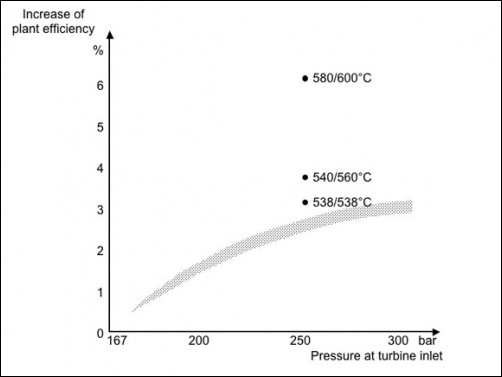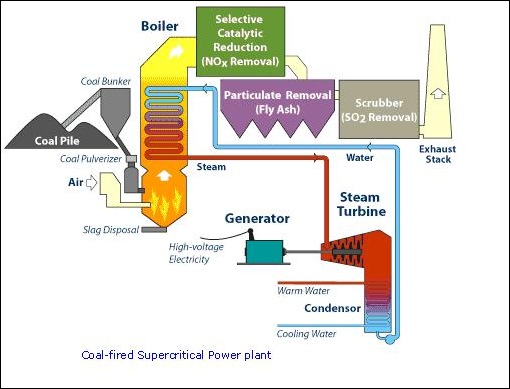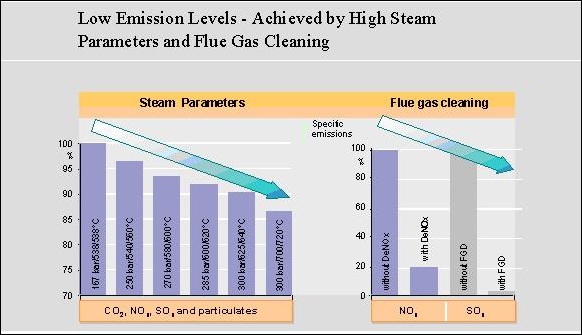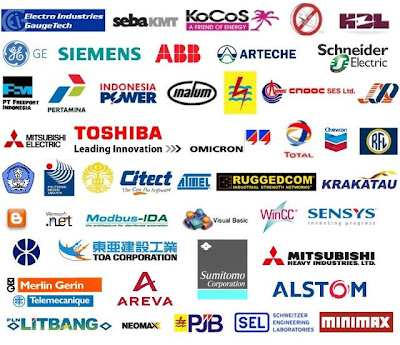Supercritical Coal-Fired Power Plant, “Clean Coal” Power Generation
17 Juli 2011, 14.58
Oleh: Ari Sulistiono di: Ilmu Listrik, Power System
‘Supercritical coal-fired power plant’ – Necessary to promote advanced technology in power generation for achieving better efficiency, cleaner and safer environment:
Introduction – Energy, in general, and electricity in particular, plays a vital role in improving the standard of life everywhere. World has abundant proven reserves of coal and thus coal-based thermal power plants dominate almost everywhere. The development of coal fired supercritical power plant technology can be described as an evolutionary advancement towards greater power output per unit and higher efficiency. Energy conversion efficiency of steam turbine cycle can be improved by increasing the main steam pressure and temperature.
As name suggests, coal-fired supercritical power plants operate at very high temperature and pressure (580 degree centigrade temp. with a pressure of 23 MPa) resulting much higher heat efficiencies (46%), as compare to sub-critical coal-fired plants which operates at 455 degree centigrade temp., and efficiency of within 40%. Some of the benefits of advanced supercritical power plants include:
(a) Reduced fuel costs due to improved plant efficiency;
(b) Significant improvement of environment by reduction in CO2 emissions;
(c) Plant costs comparable with sub-critical technology and less than other clean coal technologies;
(d) Much reduced NOx, SOx and particulate emissions;
(e) Can be fully integrated with appropriate CO2 capture technology.
Supercritical technology and its advantages - In other words, supercritical power plants are highly efficient plants with best available pollution control technology, reduces existing pollution levels by burning less coal per megawatt-hour produced, capturing the vast majority of the pollutants. This increases the kWh produced per kg of coal burned, with fewer emissions.
Because of the above techno-economic benefits along with its environment-friendly cleaner technology; more and new power plants are coming-up with this state-of-the-art technology. As environment legislations are becoming more stringent, adopting this cleaner technology have benefited immensely in all respect. As LHV (lower heating value) is improved (from 40% to more than 45%); a one percent increase in efficiency reduces by two percent, specific emissions such as CO2, NOx, SOx and particulate matters.

“Supercritical” is a thermodynamic expression describing the state of a substance where there is no clear distinction between the liquid and the gaseous phase (i.e. they are a homogenous fluid). Water reaches this state at a pressure above 22.1 MPa. The efficiency of the thermodynamic process of a coal-fired power describes how much of the energy that is fed into the cycle is converted into electrical energy. The greater the output of electrical energy for a given amount of energy input, the higher the efficiency. If the energy input to the cycle is kept constant, the output can be increased by selecting elevated pressures and temperatures for the water-steam cycle.
Increased thermal efficiency observed when the temperature and pressure of the steam is increased. By raising the temperature from 580 °C to 760 °C and the pressure out of the high pressure feed-water pump from 33 MPa to 42 MPa, the thermal efficiency improves by about 4% (Ultra-supercritical steam condition).
Moreover, there are various operational advantages in case of supercritical power plant. There are several turbine designs available for use in supercritical power plants. These designs need not fundamentally differ from designs used in sub-critical power plants. However, due to the fact that the steam pressure and temperature are more elevated in supercritical plants, the wall-thickness and the materials selected for the high-pressure turbine section need reconsideration. The supercritical plant needs ‘once-through’ boiler, where as ‘drum’ type boiler is required by sub-critical power plant. In fact, once-through boilers are better suited to frequent load variations than drum type boilers, since the drum is a component with a high wall thickness, requiring controlled heating.
The performance of supercritical plant depends on steam condition. Steam conditions up to 30 MPa/600°C/620°C are achieved using steels with 12 % chromium content. Up to 31.5 MPa/620°C/620°C is achieved using Austenite, which is a proven, but expensive, material. Nickel-based alloys, would permit 35 MPa/700°C/720°C, yielding efficiencies up to 48%. Lot R&D inputs and allying with suppliers are required to achieve higher performance.
Moreover, fuel flexibility is not compromised in Once-Through Boilers. A wide variety of fuels have already been implemented for once-through boilers. All types of coal as well as oil and gas have been used.
Conclusion – Thus, new pulverised coal combustion systems – utilising supercritical and ultra-supercritical technology – operate at increasingly higher temperatures and pressures and therefore achieve higher efficiencies than conventional sub-critical units with significant CO2 reductions. The objective of power plants within toady’s market boundaries is more than ever to ensure high efficiency (to reduce the environmental impact as much as possible) while at the same time to increase their economics in competition to existing alternatives. The development of an economical and efficient concept needs to look at the steam turbine all other main components like boiler, flue gas cleaning equipment and the optimization of the water-steam-cycle as main parts for the optimization.
Current designs of supercritical plants have installation costs that are only 2% higher than those of sub-critical plants. Fuel costs are considerably lower due to the increased efficiency and operating costs are at the same level as sub-critical plants. Specific installation cost i.e. the cost per megawatt (MW) decreases with increased plant size. This plant concept fulfils the requirement to balance reliable power supply, sustainable use of existing resources and economic operation.
Today, supercritical steam turbine cycle is the leading “clean coal” technology in widespread application. Supercritical steam cycle technology has been used for decades and is becoming the system of choice for new commercial coal-fired plants in many countries. Because of the high performance, efficiency and preservation of much cleaner environments than sub-critical coal-fired power plants, more than 500 supercritical coal-fired power plants are operating in the developed countries like US, Europe, Russia and in Japan. Most of the new power plants coming up now-a-days are of supercritical coal-fired technology. Recent plant built in Europe and Asia use supercritical boiler-turbine technology and China has made this standard on all new plant 600MW and upwards.
In fact, Supercritical steam cycles are not just applicable to coal-fired plant; oil- and gas-fired plants are also well proven. Research and development is under way for ultra-supercritical units operating at even higher efficiencies, potentially up to around 50%. The introduction of ultra-supercritical technology has been driven over recent years in countries such as Denmark, Germany and Japan, in order to achieve improved plant efficiencies and reduce fuel costs. Research is focusing on the development of new steels for boiler tubes and on high alloy steels that minimise corrosion.
References:
- http://environmentengineering.blogspot.com/2008/02/cleaner-coal-fired-supercritical-power.html
- http://environmentengineering.blogspot.com/2008/02/fludised-bed-combustion-fbc-technology.html
- http://www.powergeneration.siemens.com/NR/rdonlyres/025ABC46-9AA8-451B-88D1-FFE1B42B8966/0/2_Balancing_economics.pdf
- Y. Oka and S. Koshizuka, “Supercritical-pressure, once-through cycle light water cooled reactor concept,” Journal of Nuclear Science and Technology, vol. 38, no. 12, pp. 1081–1089, 2001.
Tags: Ilmu Listrik, Power System
Cara Membuat Spoiler atau “Tombol Show – Hide ala Kaskus” di Blogger
14 Juli 2011, 12.52
Oleh: Ari Sulistiono di: Tips & Tricks
Apa itu Spoiler?
 Spoiler adalah salah satu cara untuk menyembunyikan sebagian isi dari postingan yang kita buat. Spoiler juga bermanfaat agar konten posting yang berat seperti gambar (dalam ukuran besar) dan video [embed dari Youtube] tidak dimuat secara langsung saat halaman dibuka sebelum menekan tombol “show”. Dengan adanya spoiler dapat membantu mengurangi waktu loading sebuah situs dan memberikan opsi kepada pembaca blog untuk membuka atau tidak isi spoiler tersebut.
Spoiler adalah salah satu cara untuk menyembunyikan sebagian isi dari postingan yang kita buat. Spoiler juga bermanfaat agar konten posting yang berat seperti gambar (dalam ukuran besar) dan video [embed dari Youtube] tidak dimuat secara langsung saat halaman dibuka sebelum menekan tombol “show”. Dengan adanya spoiler dapat membantu mengurangi waktu loading sebuah situs dan memberikan opsi kepada pembaca blog untuk membuka atau tidak isi spoiler tersebut.
Jika anda sering berkunjung ke kaskus, anda akan sering melihat tombol Spoiler disana untuk nyembunyikan gambar, link, video ataupun konten lainnya. Untuk forum dengan engine vBuletin, disana sudah tersedia kode utama Spoiler sehingga pengguna cukup mengetikan kode yang sederhana di postingan yang dibuat. Kode Spoiler di Forum seperti Kaskus adalah sbb:
• Spoiler Forum, contoh Kaskus:
 [spoiler=JUDUL] ISI SPOILER [/spoiler]
[spoiler=JUDUL] ISI SPOILER [/spoiler]
Ganti tulisan yang berwarna hijau sesuai judul dan isi spoiler yang dikehendaki dan bisa di posting ke Kaskus atau Forum vBuletin lainnya. Lalu bagaimana cara membuat Spoiler untuk website pribadi ataupun Blog yang kita miliki?
• Spoiler untuk blog/web:
Untuk blog seperti Blogger.com tidak memiliki kode script internal untuk membuat Spoiler seperti halnya di vBulettin. Namun kita bisa mengetik manual kode HTML Spoiler ke source code postingan di Blogger. Caranya, buat postingan kemudian pilih metode pengeditan dengan model HTML dan copy-paste code Spoiler dibawah ini.
Berikut kode yang bisa digunakan dalam membuat spoiler di blog :
<div><div style="margin: 5px;">
<div class="smallfont" style="margin-bottom: 2px;"><i><span style="font-weight: bold;">JUDUL SPOILER…</span></i><input value="Show" style="margin: 0px; padding: 0px; width: 60px; font-size: 10px;" onclick="if (this.parentNode.parentNode.getElementsByTagName('div')[1].getElementsByTagName('div')[0].style.display != '') { this.parentNode.parentNode.getElementsByTagName('div')[1].getElementsByTagName('div')[0].style.display = ''; this.innerText = ''; this.value = 'Hide'; } else { this.parentNode.parentNode.getElementsByTagName('div')[1].getElementsByTagName('div')[0].style.display = 'none'; this.innerText = ''; this.value = 'Show'; }" type="button"/>
</div>
<div class="alt2" style="border: 1px inset ; margin: 0px; padding: 6px;">
<div style="display: none;">ISI SPOILER
</div></div></div></div>
Setelah selesai, silahkan Publish/Terbitkan postingan tersebut, maka kasilnya akan seperti berikut ini.
Tags: Tips & Tricks
未来へ - キロロ (Mirai e - Kiroro)
13 Juli 2011, 12.44
Oleh: Ari Sulistiono di: Copas & Share

Kiroro, mungkin sudah banyak diantara para readers yang mengenal grup musik ini. Meski sudah lama tiada, namun lagunya cukup enak di dengar sampai sekarang. Berhubung setiap pagi lagu ini disetel sebelum taiso dan banyak yang ingin tahu liriknya, maka saya bikin deh postingan ini.
Kiroro (キロロ) adalah sebuah grup musik jepang yang berasal dari daerah Okinawa yang cukup ngetop di tahun 1996. Kiroro beranggotakan dua orang, yaitu:
Anggota
- Chiharu Tamashiro (玉城千 Tamashiro Chiharu) - vokal
- lahir April 17, 1977 (umur 34) di Okinawa, Jepang
- Golongan darah: A
- Ayano Kinjō (金城绫 Kinjō Ayano) - Keyboard
- lahir 15 Agustus 1977 (umur 33) di Okinawa, Jepang
- Jenis Darah: AB
Kalo belum tahu Kiroro, bisa dilihat di video embed dari Youtube.com berikut ini.
Hora ashimoto o mite goran
これがあなたの歩む道
Kore ga anata no ayumu michi
ほら 前を見てごらん
Hora mae o mite goran
あれがあなたの未来
Are ga anata no mirai
母がくれたたくさんの優しさ
Haha ga kureta takusan no yasashisa
愛を抱いて歩めと繰り返した
Ai o idaite ayume to kurikaeshita
あの時はまだ幼くて意味など知らない
Ano toki wa mada osanakute imi nado shiranai
そんな私の手を握り
Sonna watashi no te o nigiri
一緒に歩んできた
Issho ni ayunde kita
夢はいつも空高くあるから
Yume wa itsumo sora takaku aru kara
届かなくて怖いね だけど追い続けるの
Todokanakute kowai ne dakedo oitsudzukeru no
自分の物語だからこそ諦めたくない
Jibun no sutoori dakara koso akirametakunai
不安になると手を握り
Fuan ni naru to te o nigiri
一緒に歩んできた
Issho ni ayunde kita
その優しさを時には嫌がり
Sono yasashisa o toki ni wa iyagari
離れた母へ素直になれず
Hanareta haha e sunao ni narezu
ほら 足元を見てごらん
Hora ashimoto o mite goran
これがあなたの歩む道
Kore ga anata no ayumu michi
ほら 前を見てごらん
Hora mae o mite goran
あれがあなたの未来
Are ga anata no mirai
その優しさを時には嫌がり
Sono yasashisa o toki ni wa iyagari
離れた母へ素直になれず
Hanareta haha e sunao ni narezu
ほら 足元を見てごらん
Hora ashimoto o mite goran
これがあなたの歩む道
Kore ga anata no ayumu michi
ほら 前を見てごらん
Hora mae o mite goran
あれがあなたの未来
Are ga anata no mirai
ほら 足元を見てごらん
Hora ashimoto o mite goran
これがあなたの歩む道
Kore ga anata no ayumu michi
ほら 前を見てごらん
Hora mae o mite goran
あれがあなたの未来
Are ga anata no mirai
未来へ向かって
Mirai e mukatte
ゆっくりと歩いて行こう
Yukkuri to aruite yukou
Terjemahan-nya kira-kira seperti ini, mungkin anak-anak PSJ UI bisa lebih detil menggambarkan lagu ini.
[the translation]
look at your feet and see
this is the path you walk
look in front of you and see
that is your future
Mother has given me a lot of kindness
"Embrace love and walk" she repeated
that time when I was childish and didn’t understand her meaning
she held my hand
together, walking we came.
dreams are always from high in the sky
it is scary that we might not reach them but continue to try
for this reason I won’t abandon my story
when I became anxous she held my hand
together, walking we came.
that kindness was occasionally unpleasant
when I was away from mother I couldn’t obey
look at your feet and see
this is the path you walk
look in front of you and see
that is your future
that kindness was occasionally unpleasant
when I was away from mother I couldn’t obey
look at your feet and see
this is the path you walk
look in front of you and see
that is your future
look at your feet and see
this is the path you walk
look in front of you and see
that is your future
slowly towards the future let’s walk
Untuk yang suka main gitar, bisa disimak kord gitar Kiroro - Mirai e berikut.
Title: “FF9 – Mirai e”
Video: Final Fantasy IX (PS)
Song: Mirai e (Kiroro)
=============================
C Em
hora ashimoto wo mite goran
Am Em
kore ga anata no ayumu michi
F G Em Am
hora mae wo mite goran
Dm G C
are ga anata no mirai
C Em
haha ga kureta
Am Em
takusan no yasashisa
F G Em Am F G
ai wo idaite ayumeto kurikaeshita
C Em F
ano toki wa mada osanakute
C# C Em/D
imi nado shiranai
Am Em Dm
sonna watashi no te wo nigiri
G C
isshoni ayundekita
C Em
yume wa itsumo
Am Em Em/D
sora takaku aru kara
F G Em Am Em/D
todokanakute kowai ne
F G
dakedo oitsuzukeruno
C Em Dm
jibun no SUTOORII dakara koso
C# C Em/D
akirametakunai
Am Em Dm
fuan ni naruto te wo nigiri
G C
isshoni ayundekita
Dm G Em Am
sono yasashisa wo toki ni wa iyagari
Em/D F G
hanareta haha e sunao ni narezu
C Em Em/D
hora ashimoto wo mite goran
Am Em
kore ga anata no ayumu michi
F G Em Am
hora mae wo mite goran
Dm G C
are ga anata no mirai
Dm G Em Am
sono yasashisa wo toki ni wa iyagari
F G
hanareta haha e sunao ni narezu
C Em Em/D
hora ashimoto wo mite goran
Am Em
kore ga anata no ayumu michi
F G Em Am
hora mae wo mite goran
Dm G C
are ga anata no mirai
C Em
hora ashimoto wo mite goran
Am Em
kore ga anata no ayumu michi
F G Em Am
hora mae wo mite goran
Dm G C
are ga anata no mirai
C Dm
Mirai e mukatte
Dm G F Em/D C
Yukkuri to aruite yukou
Terima kasih telah membaca Blog ini …
Tags: Copas & Share
Belajar Bahasa Jepang - Pertanyaan Dalam Bahasa Jepang
Idem, Di Jam 10.40
Oleh: Ari Sulistiono di: Copas & Share
 Click the links to learn how to say and write them in Japanese.
Click the links to learn how to say and write them in Japanese. | Donoyouni? | How? |
| Nani? | What? |
| Naze? | Why? |
| Itsu? | When? |
| Doko? | Where? |
| Dare? | Who? |
| Dore? | Which? |
Donoyouni - Simple Japanese Phrases
 Meaning:
Meaning:
how
Pronunciation:
Listen to the audio file for "donoyouni."
Japanese Characters:
どのように
Notes:
"Douyatte (どうやって)" can be used in informal situations.
Nani - Simple Japanese Phrases
 Meaning:
Meaning:
what
Pronunciation:
Listen to the audio file for "nani."
Japanese Characters:
何 (なに)
Notes:
"Nan" is also used as "what" depending on the situation.
Naze - Simple Japanese Phrases
 Meaning:
Meaning:
why
Pronunciation:
Listen to the audio file for "naze."
Japanese Characters:
なぜ
Notes:
"Doushite (どうして)" can be used in informal situations.
Itsu - Simple Japanese Phrases
 Meaning:
Meaning:
itsu
Pronunciation:
Listen to the audio file for "itsu."
Japanese Characters:
いつ
Doko - Simple Japanese Phrases
 Meaning:
Meaning:
doko
Pronunciation:
Listen to the audio file for "doko."
Japanese Characters:
どこ
Dare - Simple Japanese Phrases
 Meaning:
Meaning:
dare
Pronunciation:
Listen to the audio file for "dare."
Japanese Characters:
だれ
Dore - Simple Japanese Phrases
 Meaning:
Meaning:
dore
Pronunciation:
Listen to the audio file for "dore."
Japanese Characters:
どれ
Mou ichido itte kudasai - Simple Japanese Phrases
 Meaning:
Meaning:
Pardon?
Pronunciation:
Listen to the audio file for "Mou ichido itte kudasai."
Japanese Characters:
もう一度言ってください。 (もういちどいってください。)
Hontou - Simple Japanese Phrases
 Meaning:
Meaning:
Really?
Pronunciation:
Listen to the audio file for "Hontou."
Japanese Characters:
本当。 (ほんとう。)
Daijoubu - Simple Japanese Phrases
 Meaning:
Meaning:
Okay?
Pronunciation:
Listen to the audio file for "Daijoubu."
Japanese Characters:
大丈夫。 (だいじょうぶ。)
Notes:
"Daijoubu desu ka (大丈夫ですか)" can be used in formal situations.
Sou deshou - Simple Japanese Phrases
 Meaning:
Meaning:
Right?
Pronunciation:
Listen to the audio file for "Sou deshou."
Japanese Characters:
そうでしょう。
Dakara - Simple Japanese Phrases
 Meaning:
Meaning:
So?
Pronunciation:
Listen to the audio file for "Dakara."
Japanese Characters:
だから。
Tags: Copas & Share
Belajar Bahasa Jepang - Tahap Permulaan
12 Juli 2011, 10.30
Oleh: Ari Sulistiono di: About My Projects, Copas & Share

Belajar bahasa Jepang (Nihon Go), merupakan hasrat beberapa orang ketika bertemu atau bekerja dengan orang Jepang. Bisa mengucapkan beberapa kalimat sapaan yang umum adalah hal pertama yang mudah dilakukan untuk mengawalinya. Pada dasarnya saya bukanlah ahli bahasa Jepang, karena kebetulan saja beberapa kali ikut Project dengan orang Jepang, mungkin disini kita bisa belajar bersama.
Berikut ini adalah kalimat yang sering di ucapkan dalam percakapan bahasa Jepang:
[Japanese/NihonGo] : “Hai”
[Bahasa Indonesia] : “Ya”
Kata ini biasanya dipakai menyatakan setuju/iya atau pun untuk menjawab pertanyaan. Kebalikan atau lawan kata ini adalah “Iie”
[Japanese/NihonGo] : “Iie”
[Bahasa Indonesia] : “Tidak”
[Japanese/NihonGo] : “Arigatou” / “Arigatou gozaimasu” (huruf “u” diakhir kata tidak dibunyikan, hanya untuk penulisan dimana aksara Jepang tidak ada huruf mati)
[Japanese/NihonGo] : “Terima Kasih”
Gozaimasu di sini dipakai untuk ucapan formal, atau bisa juga menyatakan “terima kasih banyak”.
Berikut adalah beberapa kalimat Sapaan dalam bahasa Jepang.
[Japanese/NihonGo] : “Ohayou” / “Ohayou gozaimasu”
[Bahasa Indonesia] : “Selamat Pagi”
[Japanese/NihonGo] : “Konnichiwa”
[Bahasa Indonesia] : “Selamat Siang”
[Japanese/NihonGo] : “Konbanwa”
[Bahasa Indonesia] : “Selamat malam”
[Japanese/NihonGo] : “Yoroshiku onegaishimasu”
[Bahasa Indonesia] : “mohon bimbingannya” / “mohon bantuannya”
Kata-kata ini biasanya diucapkan pada saat memperkenalkan diri, atau pada saat hendak mengerjakan sesuatu bersama-sama.
[Japanese/NihonGo] : “O genki desu ka?” (penggunaan kata “O” di depan untuk menyatakan kalimat yang lebih sopan/halus, kata ini bisa dihilangkan untuk berbicara dengan teman sejawat)
[Bahasa Indonesia] : “Apakah Anda sehat?”
[Japanese/NihonGo] : “O kage desu” atau “Genki desu”
[Bahasa Indonesia] : “Saya sehat-sehat saja.”
digunakan untuk menjawab “O genki desu ka?”
[Japanese/NihonGo] : Kyou wa ii o tenki desu ne?
[Bahasa Indonesia] : “Cuaca hari ini bagus, bukan?”
[Japanese/NihonGo] : Youkoso!
[Bahasa Indonesia] : “Selamat datang!”
[Japanese/NihonGo] : Moshi-moshi…
[Bahasa Indonesia] : “Halo…” (berbicara lewat telepon)
Moshi-moshi hanya digunakan untuk berbicara via telepon, konon ceritanya menurut kepercayaan orang Jepang kata ini dipakai karena tidak ada setan atau jin tidak bisa mengucapkan kata ini dengan baik, berharap agar yang di telepon bukanlah seorang setan/jin maka kata ini dipakai untuk mengawali pembicaraan lewat telepon. Apakah mitos ini betul atau tidak saya juga kurang tahu persis, karena cerita ini dikisahkan oleh anak-anak Pusat Sastra Jepang UI, bukan orang Jepangnya langsung.
[Japanese/NihonGo] : Gomen na sai
[Bahasa Indonesia] : “Mohon maaf”
[Japanese/NihonGo] : Sumimasen
[Bahasa Indonesia] : “Permisi”
Sumimasen > (bisa juga diterapkan untuk minta maaf seperti “gomen na sai”)
[Japanese/NihonGo] : Zannen desu
[Bahasa Indonesia] : “sayang sekali” / “amat disayangkan”
[Japanese/NihonGo] : Omedetou, ne
[Bahasa Indonesia] : “Selamat ya”
Omedetou, ne > (untuk beberapa hal yang baru dicapai, e.g. kelulusan, menang lomba, dsb)
[Japanese/NihonGo] : Dame / Dame desu yo
[Bahasa Indonesia] : “jangan” / “sebaiknya jangan”
[Japanese/NihonGo] : Suteki desu ne
[Bahasa Indonesia] : “Bagus ya…” / “indah ya…”
Suteki desu ne > (untuk menyatakan sesuatu yang menarik, e.g. ‘hari yang indah’)
[Japanese/NihonGo] : Sugoi! / Sugoi desu yo!
[Bahasa Indonesia] : “Hebat!”
[Japanese/NihonGo] : Sou desu ka
[Bahasa Indonesia] : “Jadi begitu…”
Sou desu ka > (menyatakan pengertian atas suatu masalah)
[Japanese/NihonGo] : Daijoubu desu / Heiki desu
[Bahasa Indonesia] : “(saya) tidak apa-apa” / “(saya) baik-baik saja”
Jika Anda Kesulitan menangkap Ucapan Lawan Bicara Anda
[Japanese/NihonGo] : Chotto yukkuri itte kudasai.
[Bahasa Indonesia] : “Tolong ucapkan lagi dengan lebih lambat.”
[Japanese/NihonGo] : Mou ichido itte kudasai.
[Bahasa Indonesia] : “Tolong ucapkan sekali lagi.”
[Japanese/NihonGo] : Motto hakkiri itte kudasai.
[Bahasa Indonesia] : “Tolong ucapkan dengan lebih jelas.”
Untuk Mengakhiri Pembicaraan
[Japanese/NihonGo] : Sayonara
[Bahasa Indonesia] : “Selamat tinggal”
[Japanese/NihonGo] : Mata aimashou
[Bahasa Indonesia] : “Ayo bertemu lagi kapan-kapan”
[Japanese/NihonGo] : Ja, mata / mata ne
[Bahasa Indonesia] : “Sampai jumpa”
[Japanese/NihonGo] : Mata ashita
[Bahasa Indonesia] : “Sampai jumpa besok”
Beberapa Kalimat yang Tidak Selalu Muncul dalam Dialog, tetapi merupakan Elemen Kebudayaan Jepang
[Japanese/NihonGo] : Irasshaimase!
[Bahasa Indonesia] : “Selamat datang!”
Irasshaimase! > (kalimat ini hanya diucapkan oleh petugas toko ketika Anda berkunjung)
[Japanese/NihonGo] : Ittekimasu!
[Bahasa Indonesia] : “Berangkat sekarang!”
[Japanese/NihonGo] : Itterasshai
[Bahasa Indonesia] : “Hati-hati di jalan”
Itterasshai > (diucapkan ketika seseorang hendak pergi ke luar rumah; umumnya sebagai jawaban untuk “Ittekimasu”)
[Japanese/NihonGo] : Itadakimasu
[Bahasa Indonesia] : [literal] “Terima kasih atas makanannya”
Itadakimasu > (kalimat ini sebenarnya tidak diartikan secara harfiah. Masyarakat Jepang biasanya mengucapkan kalimat ini sebagai ungkapan rasa syukur atas makanan yang dihidangkan)
[Japanese/NihonGo] : Gochisousama deshita
[Bahasa Indonesia] : [literal] “perjamuan/hidangan sudah selesai”
Gochisousama deshita > (seperti “Itadakimasu”, kalimat ini juga tidak diartikan secara harfiah. Masyarakat Jepang pada umumnya mengucapkan kalimat ini seusai makan)
Tags: About My Projects, Copas & Share



 View
View